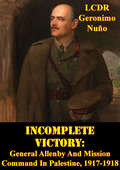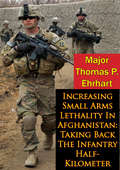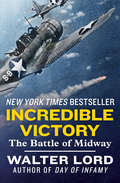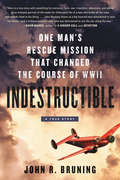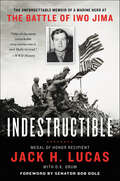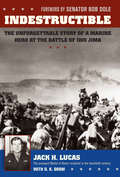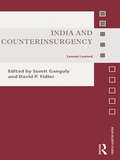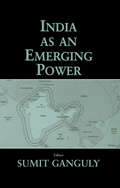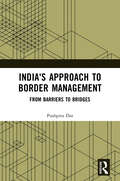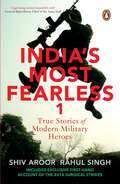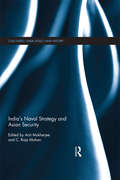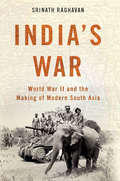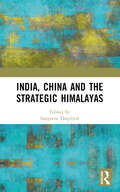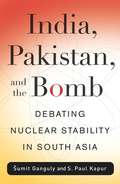- Table View
- List View
Incomparable: a collection of essays
by Terry CrowdyAn elite battalion under Louis XVI, the 9th Light Infantry regiment were with Napoleon from almost the beginning of his campaigns, so much so that he dubbed them 'Incomparable'. This collection of essays studies their early history and formation, prior to being so vital during the Napoleonic Wars.
Incomplete Victory: General Allenby And Mission Command In Palestine, 1917-1918
by Lcdr Geronimo NuñoThe Palestine Campaign of the First World War exhibited a fighting style that brought with it various challenges in mission command. While General Allenby, commanding the Allied Egyptian Expeditionary Force (EEF), gained several victories in the early stages of the campaign, he did not comprehensively defeat the Turkish forces in Palestine. He drove them away from their defensive line, but they escaped, avoided destruction, and retreated north to re-establish a defense and engage the EEF at later date. This thesis argues that General Allenby did not achieve the great successes at the battles of Beersheba, Gaza, Sheria, and the pursuit of Turkish forces that ended with Allenby's capture of Jerusalem. Instead, Allenby had to learn how to succeed in Palestine to finally destroy the armies of the Ottoman Empire in Palestine at the battle of Megiddo in September 1918. The research in this study highlights the mission command challenges in Allenby's early campaigns and how he learned to overcome them and adapt his tactics to achieve complete victory at the battle of Megiddo. This thesis will use the tenets of mission command, consisting preparation, combined arms, prioritization of resources, and communication, to examine General Allenby's Palestine campaign. Mission command, both a function of war and a philosophy of leadership comprises one of the key facets of military thought that leaders must consider in order to achieve complete victory.
Increasing Aircraft Carrier Forward Presence: Changing the Length of the Maintenance Cycle
by Clifford A. Grammich John F. Schank Roland J. Yardley James G. KallimaniThe U.S. Navy's aircraft carrier fleet must meet the forward presence requirements of theater commanders. With a decreasing fleet size, planners must balance the timing of maintenance, training, and deployment with presence and surge demands. Evaluating multiple one- and two-deployment scenarios per cycle, RAND examines the feasibility of different cycle lengths, their effect on carrier forward presence, and their impact on shipyard workloads.
Increasing Small Arms Lethality In Afghanistan: Taking Back The Infantry Half-Kilometer
by Major Thomas P. EhrhartOperations in Afghanistan frequently require United States ground forces to engage and destroy the enemy at ranges beyond 300 meters. These operations occur in rugged terrain and in situations where traditional supporting fires are limited due to range or risk of collateral damage. With these limitations, the infantry in Afghanistan require a precise, lethal fire capability that exists only in a properly trained and equipped infantryman. While the infantryman is ideally suited for combat in Afghanistan, his current weapons, doctrine, and marksmanship training do not provide a precise, lethal fire capability to 500 meters and are therefore inappropriate.Comments from returning non-commissioned officers and officers reveal that about fifty percent of engagements occur past 300 meters. The enemy tactics are to engage United States forces from high ground with medium and heavy weapons, often including mortars, knowing that we are restricted by our equipment limitations and the inability of our overburdened soldiers to maneuver at elevations exceeding 6000 feet. Current equipment, training, and doctrine are optimized for engagements under 300 meters and on level terrainThere are several ways to extend the lethality of the infantry. A more effective 5.56-mm bullet can be designed which provides enhanced terminal performance out to 500 meters. A better option to increase incapacitation is to adopt a larger caliber cartridge, which will function using components of the M16/M4. The 2006 study by the Joint Service Wound Ballistics-Integrated Product Team discovered that the ideal caliber seems to be between 6.5 and 7-mm. This was also the general conclusion of all military ballistics studies since the end of World War I.
Incredible Seney
by Lewis C. ReimannThe first complete story of Michigan’s fabulous lumber town, this is the third book in a series dealing with the pioneer life in the Upper Peninsula of Michigan. First published in 1953 it was written by Upper Peninsula native, Lewis C. Reimann, “with the assistance of many witnesses of the early scenes of that rugged period—old time lumberjacks, woods bosses, descendants of the pioneer families and many others interested in those hardy people.”It is richly illustrated throughout with black & white photographs.
Incredible Victory: The Battle of Midway
by Walter LordThe &“remarkable&” New York Times bestseller about the battle in the Pacific that turned the tide of World War II—from the author of The Miracle of Dunkirk (Los Angeles Times). On the morning of June 4, 1942, doom sailed on Midway. Hoping to put itself within striking distance of Hawaii and California, the Japanese navy planned an ambush that would obliterate the remnants of the American Pacific fleet. On paper, the Americans had no chance of winning. They had fewer ships, slower fighters, and almost no battle experience. But because their codebreakers knew what was coming, the American navy was able to prepare an ambush of its own. Over two days of savage battle, American sailors and pilots broke the spine of the Japanese war machine. The United States prevailed against momentous odds; never again did Japan advance. In stunning detail, Walter Lord, the #1 New York Times–bestselling author of Day of Infamy and A Night to Remember, tells the story of one of the greatest upsets in naval history. &“Graphic and realistic . . . not an impersonalized account of moves on the chessboard of war, [but] a story of individual people facing crucial problems.&” —The New York Times
Incredible Victory: The Battle of Midway (Classics Of War Ser.)
by Walter LordThe &“remarkable&” New York Times bestseller about the battle in the Pacific that turned the tide of World War II—from the author of The Miracle of Dunkirk (Los Angeles Times). On the morning of June 4, 1942, doom sailed on Midway. Hoping to put itself within striking distance of Hawaii and California, the Japanese navy planned an ambush that would obliterate the remnants of the American Pacific fleet. On paper, the Americans had no chance of winning. They had fewer ships, slower fighters, and almost no battle experience. But because their codebreakers knew what was coming, the American navy was able to prepare an ambush of its own. Over two days of savage battle, American sailors and pilots broke the spine of the Japanese war machine. The United States prevailed against momentous odds; never again did Japan advance. In stunning detail, Walter Lord, the #1 New York Times–bestselling author of Day of Infamy and A Night to Remember, tells the story of one of the greatest upsets in naval history. &“Graphic and realistic . . . not an impersonalized account of moves on the chessboard of war, [but] a story of individual people facing crucial problems.&” —The New York Times
Indelible: A Story of Life, Love, and Music in Five Movements
by Elliot H. PaulElliot H. Paul’s Indelible: A Story of Life, Love, and Music in Five Movements is a beautifully composed novel that intertwines the passions of life, the complexities of love, and the transformative power of music. Structured like a symphony, the story unfolds in five movements, each capturing a unique phase of the protagonist’s journey through a richly textured narrative.At the heart of the story is a gifted musician whose life is marked by both extraordinary triumphs and deep personal struggles. From the vibrant streets of Paris to intimate concert halls, the novel explores how music shapes his identity, relationships, and his search for meaning. Through love affairs, friendships, and moments of profound loss, Paul paints a poignant portrait of a life lived in harmony and discord with the world around him.Paul’s evocative prose resonates with the rhythm and emotion of a musical score, immersing readers in the sights, sounds, and sentiments of each scene. His characters are deeply human, their flaws and virtues intricately drawn, creating a narrative that is both personal and universal.Indelible is a celebration of art’s enduring impact on the human spirit and a meditation on the interconnectedness of life’s most profound experiences. With its lyrical storytelling and emotional depth, this novel is a must-read for lovers of music, literature, and timeless tales of passion and perseverance.
Indestructible: One Man's Rescue Mission That Changed the Course of WWII
by John R BruningIn this remarkable WWII story by New York Times bestselling author John R. Bruning, a renegade American pilot fights against all odds to rescue his family--imprisoned by the Japanese--and revolutionizes modern warfare along the way.From the knife fights and smuggling runs of his youth to his fiery days as a pioneering naval aviator, Paul Irving "Pappy" Gunn played by his own set of rules and always survived on his wits and fists. But when he fell for a conservative Southern belle, her love transformed him from a wild and reckless airman to a cunning entrepreneur whose homespun engineering brilliance helped launch one of the first airlines in Asia.Pappy was drafted into MacArthur's air force when war came to the Philippines; and while he carried out a top-secret mission to Australia, the Japanese seized his family. Separated from his beloved wife, Polly, and their four children, Pappy reverted to his lawless ways. He carried out rescue missions with an almost suicidal desperation. Even after he was shot down twice and forced to withdraw to Australia, he waged a one-man war against his many enemies--including the American high command and the Japanese--and fought to return to the Philippines to find his family.Without adequate planes, supplies, or tactics, the U.S. Army Air Force suffered crushing defeats by the Japanese in the Pacific. Over the course of his three-year quest to find his family, Pappy became the renegade who changed all that. With a brace of pistols and small band of loyal fol,lowers, he robbed supply dumps, stole aircraft, invented new weapons, and modified bombers to hit harder, fly farther, and deliver more destruction than anything yet seen in the air. When Pappy's modified planes were finally unleashed during the Battle of the Bismarck Sea, the United States scored one of the most decisive victories of World War II. Taking readers from the blistering skies of the Pacific to the jungles of New Guinea and the Philippines to one of the the war's most notorious prison camps, Indestructible traces one man's bare-knuckle journey to free the people he loved and the aerial revolution he sparked that continues to resonate across America's modern battlefields.
Indestructible: The Unforgettable Memoir of a Marine Hero at the Battle of Iwo Jima
by Jack H. Lucas D. K. DrumThe classic World War II memoir of a U.S. Marine's heroism at Iwo Jima from a Medal of Honor recipient.Foreword by Bob Dole“One of the most remarkable true stories one is ever likely to read.” —WWII HistoryOn February twenty, 1945, the second day of the assault on Iwo Jima—one of the bloodiest battles of the Pacific theater in World War II—Private Jack Lucas, who was only seventeen, and three other Marines engaged in a close-proximity firefight with Japanese soldiers. When two enemy grenades landed in their trench, Lucas jumped on one and pulled the other under his body to save the lives of his comrades. Lucas was blown into the air as his body was torn apart by 250 entrance wounds. He was so severely wounded that his team left him for dead. Miraculously, he survived.While on the hospital ship Samaritan, his spirit soared to see the American flag flying atop Mount Suribachi—the same flag immortalized in Joe Rosenthal’s iconic photograph, Raising the Flag on Iwo Jima. Lucas endured twenty-one grueling surgeries and carried 200 pieces of shrapnel in his body for the rest of his life. Awarded the Medal of Honor, he became the youngest Marine in U.S. history—and the youngest of all World War II servicemen—to receive the honor.Indestructible tells the remarkable story of an extraordinary American possessed with a fierce determination to serve his country.
Indestructible: The Unforgettable Story of a Marine Hero at Iwo Jima
by Jack Lucas D. K. DrumDuring the battle of Iwo Jima, two enemy grenades landed close to Jack Lucas and his buddies. Jack threw himself on one of the grenades, grabbed the second, and pulled it beneath his body. His buddies were saved, but Lucas was badly injured. Miraculously, he survived-but just barely. For this brave action seventeen-year-old Jack Lucas from North Carolina became the youngest Marine in history to receive the Medal of Honor. Indestructible reveals the rocky road that led Jack Lucas to Iwo Jima, his arduous recovery, and the obstacles Jack overcame later in life. Jack’s moving and powerful memoir is a testament to America’s greatest generation.
India Redefines its Role (Adelphi series #293)
by Shekhar GuptaFirst Published in 2005. Routledge is an imprint of Taylor & Francis, an informa company.
India and Counterinsurgency: Lessons Learned (Asian Security Studies)
by Sumit Ganguly David P. FidlerThis edited volume focuses on India's experiences waging counterinsurgency campaigns since its independence in 1947. Filling a clear gap in the literature, the book traces and assess the origins, evolution and current state of India's counterinsurgency strategies and capabilities, focusing on key counterinsurgency campaigns waged by India within and outside its territory. It also analyzes the development of Indian doctrine on counterinsurgency, and locates this within the overall ebb and flow of India's defense and security policies. The central argument is that counterinsurgency has been an integral part of India's overall security policy and can thereby impart much to political and military leaders in other states. Since its emergence from British colonialism, India's defence policies have not merely sought to protect and preserve India's inherited colonial borders from threats by rival states, but have also sought to prevent and suppress secessionist movements. In countering insurgencies, the Indian state has fashioned strategies that seek to repress militarily any secessionist movement, while simultaneously forging a range of civilian administrative and institutional arrangements that attempt to address the grievances of disaffected populations. The book highlights key strategic and tactical innovations that the Indian Army and security forces made to deal with a range of insurgent movements. Simultaneously, it also examines how the civilian-military nexus enabled India's policy makers to utilize existing, and formulate novel, institutional means to address extant political grievances. India has been most successful where it has managed to use calibrated force, obtained the trust of much of the aggrieved population and made persuasive commitments to political and institutional reform. Examination of these elements of India's counterinsurgency performance can be compared to counterinsurgency doctrine developed by other countries, including the United States, and thus yield comparative policy prescriptions and recommendations that can be applied to other counterinsurgency contexts. This book will be of great interest to students of counterinsurgency and irregular warfare, Indian politics, Asian Security Studies and Strategic Studies in general.
India and Global Governance: A Rising Power and Its Discontents
by Harsh V PantThis volume explores India’s role in the global governance architecture post–Cold War. It shows how, with a rise in India’s capabilities, there is an expectation from its external interlocutors that New Delhi ought to play a larger global role. As Indian policymakers redefine their engagements in the global policy matrix, the chapters in the volume analyse India’s role as a challenger and a stakeholder in world politics; its uneasy relationship with Western liberal democracies; and its role in shaping new structures of global governance. The volume focuses on a host of critical issues, including nuclear policy, climate action politics, India’s bid for a permanent seat at the UN Security Council, humanitarian interventions, trade governance, democracy promotion, India’s engagement with other emerging powers in platforms such as the BRICS, the changing dynamics with its neighbours, and maritime governance. A timely reimagining of global politics, this book will be of great interest to scholars and researchers of politics and international relations, climate change, military and strategic studies, economics, and South Asian studies.
India as an Emerging Power
by Sumit GangulyThese essays examine India's relations with key powers including the Russian Federation, China and the USA and with key adversaries in the global arena in the aftermath of the Cold War. One positive relationship is that of India's relations with Israel since 1992.
India's Approach to Border Management: From Barriers to Bridges
by Pushpita DasThis book attempts to provide a comprehensive understanding of the circumstances which have shaped India’s approach towards its international borders and the framework it has developed to better manage its borders. The book argues that persistence of various cross-border threats and challenges and an absence of robust intra-regional trade among its neighbouring countries forced India to employ a security-centric and unilateral approach to border management with emphasis on hardening the borders to cross-border trade and travel and keeping the border areas underdeveloped to act as a buffer against external conventional threats. Besides discussing the threats and challenges that India faces along the borders, the book aims to develop an understanding of India’s border management practices by analysing various programmes and initiatives such as the raising of border guarding forces; building of physical and electronic fences; the establishment of modern facilities for smoothening legitimate cross-border travel; the development of the border areas through special programmes; and increasing trade and connectivity as well as other cooperative bilateral mechanisms. Print edition not for sale in South Asia (India, Sri Lanka, Nepal, Bangladesh, Pakistan and Bhutan).
India's Doctrine Puzzle: Limiting War in South Asia
by Ali AhmedThe balance of power in South Asia is tenuous. Neighbouring states with nuclear arsenal pose a serious threat in times of conflict and the danger of escalation into a nuclear holocaust in South are ever-present. This book locates the change in India’s war doctrine at the turn of the century, following the Kargil War in 1999 between India and Pakistan. It examines how war policy was shaped by the threat posed by India’s neighbours and the need for greater strategic assertion. It also reveals that this change was forced by the military’s need to adapt itself to the nuclear age. Finally, it raises questions of whether the Limited War doctrine has made India more secure. An astute analysis of not only India’s military strategy but also of military doctrine in general, this book will be valuable to scholars and researchers of defence and strategic studies, international relations, peace and conflict studies, South Asia studies as well as government and military institutions.
India's Most Fearless True Stories of Modern Military Heroes: True Stories Of Modern Military Heroes
by Rahul Singh Shiv AroorThe Army major who led the legendary September 2016 surgical strikes on terror launch pads across the LoC; a soldier who killed 11 terrorists in 10 days; a Navy officer who sailed into a treacherous port to rescue hundreds from an exploding war; a bleeding Air Force pilot who found himself flying a jet that had become a screaming fireball . . . Their own accounts, or of those who were with them in their final moments. India's Most Fearless covers fourteen true stories of extraordinary courage and fearlessness, providing a glimpse into the kind of heroism our soldiers display in unthinkably hostile conditions and under grave provocation.
India's Naval Strategy and Asian Security (Cass Series: Naval Policy and History)
by C. Raja Mohan Anit MukherjeeThis book examines India’s naval strategy within the context of Asian regional security. Amidst the intensifying geopolitical contestation in the waters of Asia, this book investigates the growing strategic salience of the Indian Navy. Delhi’s expanding economic and military strength has generated a widespread debate on India’s prospects for shaping the balance of power in Asia. This volume provides much needed texture to the abstract debate on India’s rise by focusing on the changing nature of India’s maritime orientation, the recent evolution of its naval strategy, and its emerging defence diplomacy. In tracing the drift of the Navy from the margins of Delhi’s national security consciousness to a central position, analysing the tension between its maritime possibilities and the continentalist mind set, and in examining the gap between the growing external demands for its security contributions and internal ambivalence, this volume offers rare insights into India’s strategic direction at a critical moment in the nation’s evolution. By examining the internal and external dimensions of the Indian naval future, both of which are in dynamic flux, the essays here help a deeper understanding of India’s changing international possibilities and its impact on Asian and global security. This book will be of much interest to students of naval strategy, Asian politics, security studies and IR, in general.
India's War: World War II and the Making of Modern South Asia
by Srinath RaghavanIndia's role in World War II has long been overlooked. But as Srinath Raghavan shows in this authoritative account, India did not fight the war as merely an appendage of the British Empire. From the start, India defended its own sub-empire from Imperial Japan and assisted its allies in battles in Italy, East Africa, and the Pacific.The war also brought great changes to the subcontinent. By the war's end, the Indian Army had become the largest volunteer force in history, while many millions more Indians had worked in their nation's rapidly expanding industry and agriculture. This nationwide commitment to victory altered the country's social landscape, overturning assumptions about class and opening up new opportunities for India's most disadvantaged people.The first major account of India during World War II, India's War chronicles how the demands of war forever transformed the country, its economy, its politics, and its people, laying the groundwork for the rise of modern South Asia.
India, China and the Strategic Himalayas
by Sangeeta ThapliyalThis book analyses strategic discourse on the Himalayas from the perspective of India’s interests. Home to many communities, cultures, natural resources and political boundaries, it is the geopolitical landscape of the Himalayas between India and China that dominates other narratives and discourses. The traditional notion of Himalayas as India’s frontiers and buffer is challenged by China. Despite various mechanisms to address border resolution there are violations and transgressions from China. This book examines India’s responses to the new emerging challenges in the Himalayas. How the statist discourse on strategic interests incorporates people’s discourse. It provides a nuanced understanding of India’s strategic undertakings, diplomatic initiatives and development framework. This book will be a valuable addition to existing knowledge on the Himalayas between India and China. Scholars and practitioners interested in International Relations, Strategic Studies, Himalayan Studies and South Asian Studies will find it useful. Print edition not for sale in South Asia (India, Sri Lanka, Nepal, Bangladesh, Pakistan and Bhutan)
India, Pakistan and the Secret Jihad: The Covert War in Kashmir, 1947-2004 (Asian Security Studies)
by Praveen SwamiIndia, Pakistan and the Secret Jihad explores the history of jihadist violence in Kashmir, and argues that the violent conflict which exploded after 1990 was not a historical discontinuity, but, rather, an escalation of what was by then a five-decade old secret war. Praveen Swami addresses three key issues: the history of jihadist violence in Jammu and Kashmir, which is examined as it evolved from 1947-48 onwards the impact of the secret jihad on Indian policy-making on Jammu and Kashmir, and its influence on political life within the state why the jihad in Jammu and Kashmir acquired such intensity in 1990. This new work will be of much interest to students of the India-Pakistan conflict, South Asian politics and security studies in general.
India, Pakistan, and the Bomb: Debating Nuclear Stability in South Asia
by Ganguly Umit S. Paul KapurIn May 1998, India and Pakistan put to rest years of speculation as to whether they possessed nuclear technology and openly tested their weapons. Some believed nuclearization would stabilize South Asia; others prophesized disaster. Authors of two of the most comprehensive books on South Asia's new nuclear era, Sumit Ganguly and S. Paul Kapur, offer competing theories on the transformation of the region and what these patterns mean for the world's next proliferators. Ganguly begins with an outcome-based approach emphasizing the results of militarized conflict. In his opinion, nuclear weapons have prevented Indo-Pakistani disputes from blossoming into full-scale war. Kapur counters with a process-based approach stressing the specific pathways that lead to conflict and escalation. From his perspective, nuclear weapons have fueled a violent cycle of Pakistani provocation and Indian response, giving rise to a number of crises that might easily have spun into chaos. Kapur thus believes nuclear weapons have been a destabilizing force in South Asia and could similarly affect other parts of the world. With these two major interpretations, Ganguly and Kapur tackle all sides of an urgent issue that has profound regional and global consequences. Sure to spark discussion and debate, India, Pakistan, and the Bomb thoroughly maps the potential impact of nuclear proliferation.
India, South Korea and the ASEAN: Middle Power Diplomacy in the Indo-Pacific
by Harsh V PantWith the US-China geostrategic competition heating up, it is an opportune time for South Korea, ASEAN and India to draw on their middle power status to bolster regional security and economic cooperation to protect their interests from any potential superpower fallout. This book investigates the diverse possibilities for collaboration within the India-ASEAN-ROK trilateral framework. It explores the various avenues of cooperation that this new trilateral initiative can benefit from, ranging from security, economic, institutional platforms and technology to sustainable development and climate change. The book provides regional perspectives on India, ASEAN and ROK to show the growing appetite in these countries for such trilateral initiatives and to forecast the challenges that may arise.Lucid and topical, this book will be an essential read for scholars and researchers of political science, international relations, diplomacy and strategic studies, as well as Southeast Asian, East Asian and South Asian studies. It will also be of use to thinktanks and policymakers interested in Indo-Pacific, India-ASEAN and India-ROK issues.
India-China Maritime Competition: The Security Dilemma at Sea (Cass Series: Naval Policy and History)
by T. V. Paul Rajesh Basrur Anit MukherjeeThis edited volume critically examines the concept of the “security dilemma” and applies it to India–China maritime competition. Though frequently employed in academic discussion and popular commentary on the Sino-Indian relationship, the term has rarely been critically analysed. The volume addresses the gap by examining whether the security dilemma is a useful concept in explaining the naval and foreign policy strategies of India and China. China’s Belt and Road Initiative and its expansive engagement in the Indian Ocean Region have resulted in India significantly scaling up investment in its navy, adding ships, naval aircraft and submarines. This volume investigates how the rivalry is playing out in different sub-regions of the Indian Ocean, and the responses of other powers, notably the United States and prominent Southeast Asian states. Their reactions to the Sino-Indian rivalry are an underexplored topic and the chapters in this book reveal how they selectively use that rivalry while trying to steer clear of making definite choices. The book concludes with recommendations on mitigating the security dilemma. This work will be of great interest to students of strategic studies, international relations, maritime security, and Asian politics.

